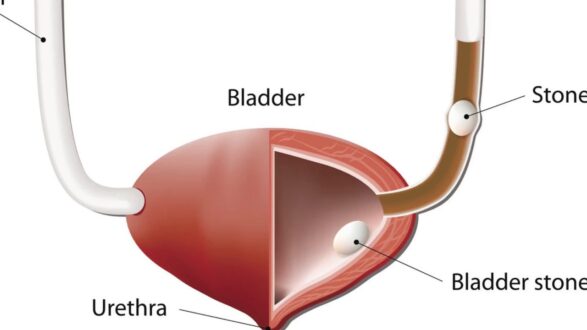Learn all about cystolitholapaxy procedure, recovery time, complications and anesthesia.
Cystolitholapaxy is a safe and effective operation to treat bladder stones. This is a minimally-invasive procedure where the stones in the bladder are destroyed with a laser and all the pieces are removed, without the need for any incisions. The procedure may be done at the same time as another procedure to treat the prostate, such as a transurethral resection of the prostate or Green Light laser vapourization of the prostate.
Perforation of the bladder is a typical complication. Beware of using the electrohydraulic lithotripsy near the bladder wall. Caution in grasping the bladder wall with the stone punch. Urinary tract infections are the most common complication associated with a cystolitholapaxy. About 1 in 10 people develop urinary tract infections (UTIs) after bladder surgery. UTIs may be treated with antibiotics.
Further complications are bleeding, infection, urethral injury. Conversion to open surgery is necessary, if the stone burden was underestimated. The role of cystolitholapaxy over the last ten years has undergone a dramatic evolution, due to the advent of holmium laser. Stone that were routinely removed using an open incision may now be broken into multiple smaller pieces and removed through a natural body opening (the urethra), avoiding both the pain and the recovery of an open incision.
Most patients will stay in for at least one night after the operation, and the catheter can be removed when the urine is clear. You will be discharged when fit, and will be advised to rest at home for a few days. Specific advice will be given on discharge. After surgery, you may be asked to attend a follow-up appointment where an X-ray or CT scan can be used to check that all fragments of the bladder stones have been removed from your bladder.
What is Cystolitholapaxy?
Cystolitholapaxy is a procedure to break up bladder stones into smaller pieces and remove them. Bladder stones are minerals that have built up in the bladder. Ultrasonic waves or lasers may be delivered through a tool called a cystoscope to break up the stones. Cystolitholapaxy is the most common procedure which is being used to break up bladder stones into smaller pieces and remove them. Cystolitholapaxy is usually performed by a urologist in an outpatient setting.
Cystolitholapaxy Procedure
A tool called a cystoscope, a tiny flexible probe with a camera attached to the end, is inserted into the patient’s bladder. The cystoscope is then used to deliver ultrasonic waves or laser to break up the stones into tiny pieces. These small pieces can then be flushed from the bladder with fluids.
The surgeon may place a stent into the patient’s urethra to help protect the lining and allow the fragments to pass out of the body. There are 2 different cystolitholapaxy procedures, as described below:
Transurethral cystolitholapaxy: This is the surgical procedure used most often to treat bladder stones in adults. It is performed under general or local anesthesia. The cystoscope is inserted into the bladder through the urethra. Laser or ultrasonic waves are transmitted through it to crush the stones into smaller pieces. A mechanical crushing device may be used instead. The remaining fragments may be washed out of the bladder with fluids.
Percutaneous suprapubic cystolitholapaxy: This procedure is used in cases where transurethral cystolitholapaxy would not be suitable or effective. The surgery is performed under general anesthesia. The procedure requires 2 cuts to be made: 1 cut in the skin of the lower abdomen and another cut in the wall of the bladder. The cystoscope is then inserted through the incisions and the stones are broken up with a laser or ultrasound waves. Percutaneous suprapubic cystolitholapaxy is the preferred method when treating children with bladder stones. The urethra is narrower in children and it is more difficult to insert a cystoscope. This technique is also used for adults with large bladder stones.
Cystolitholapaxy Recovery Time
It may take several weeks to recover from a cystolitholapaxy. You may have to take 3 to 4 weeks off of work, and even more time if your job requires physical activity or heavy lifting..
Cystolitholapaxy Complications
Problems from the procedure are rare, but all procedures have some risk. Your doctor will review potential problems, such as:
- Urinary tract infection
- Bladder tear or damage
- Bleeding
- Reaction to the anesthesia
- Infection
- Damage to internal tissue or structures;
- Temporary inability to urinate
- Bladder irritation causing increased frequency and urgency of urination
- Burning during urination
- Scarring along the opening of the bladder, requiring additional treatments in the future
- Regrowth of bladder stones
- General risks associated with all types of surgery including heart attack, stroke and blood clots in the
- Legs or lungs
Cystolitholapaxy Anesthesia
Cystolitholapaxy is done under local, spinal, or general anesthesia. It will block any pain. Sedation may also be used to ease anxiety. With local anesthesia, a special jelly or fluid will be inserted into your urethra. This will numb the area. If you are having spinal anesthesia, it will be injected into your spine. General anesthesia will make you stay asleep during the procedure.
 Health & Care Information
Health & Care Information 


